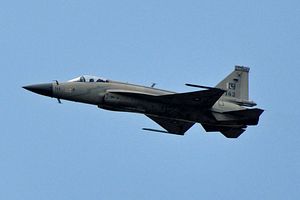Pakistan’s military said on February 27 that it has shot down two Indian Air Force (IAF) fighter jets that had entered Pakistani airspace, capturing a pilot.
“IAF crossed LOC [Line of Control]. PAF shot down two Indian aircrafts inside Pakistani airspace,” according to Pakistan’s military spokesman. “One of the aircraft fell inside AJ&K [Azad Kashmir] while other fell inside IOK [Indian-occupied Kashmir]. One Indian pilot arrested by troops on ground while two in the area.” The alleged captured IAF pilot, Wing Commander Abhi Nandan, the spokesperson said in a separate statement, “is being treated as per norms of military ethics.”
India confirmed that one of its planes was shot down by Pakistani planes and said a pilot is missing in a statement issued on February 27 by the Indian Ministry of External Affairs. “In that aerial engagement, one Pakistan Air Force [PAF] fighter aircraft was shot down by a MiG 21 Bison of the Indian Air Force,” the statement reads. “The Pakistani aircraft was seen by ground forces falling from the sky on the Pakistan side. In this engagement, we have unfortunately lost one MiG 21. The pilot is missing in action.”
Pakistan has rejected India’s claim that a Pakistani fighter jet had been shot down.
The first MiG-21s entered service with the IAF in the 1960s. They are among the most accident-prone fighter jets ever to be inducted into service by the IAF. The MiG-21 Bison is an upgraded version of the Russian-made baseline MiG-21. According to unconfirmed media reports, the PAF military aircraft that shot down the Mig-21 Bison was an Aeronautical Complex/Chengdu Aerospace Corporation (PAC/CAC) JF-17 “Thunder” Block II multirole fighter jet. (Other reports claim that a PAF F-16 engaged the IAF fighters.)
“Proud to announce, I was project director for JF-17 Thunder program jointly produced by Pakistan and China during the tenure of General Pervez Musharraf,” retired PAF Air Marshall Shahid Latif said in a statement on social media today. “Today, same jets targeted and shot down Indian Jets which entered Pakistani Airspace.”
Some reports claim that the IAF jets were engaged with beyond-visual-range air-to-air missiles (BVRAAM). Notably, the PAF is in the process of integrating the Chinese-made PL-12 BVRAAM with the JF-17. (An unnamed BVRAAM has recently been test fired by the PAF.) As of today, there is no publicly available data to verify what aircraft type engaged the IAF jets. Nonetheless, if confirmed it would constitute the first kill of an aircraft by a JF-17. (A JF-17 shot down an Iranian drone in 2017.)
Yet, it could also point to a F-16 given that the aircraft can carry AIM-120C-7 advanced medium-range air-to-air missiles (AMRAAMs), which too would fit the description of the weapon system used in the dog fight, according to preliminary reports.
The JF-17 was originally developed to replace the PAF’s aging fleet of Dassault Mirage III/5 fighter jets by the early 2020s. The PAF is expected to induct 150 JF-17 combat aircraft over the next years, split into three productions blocks: Block I, Block II, and Block-III. PAC has so far produced 50 Block I aircraft and over 60 Block II JF-17s.
PAC has an annual domestic production capability of 25 JF-17 aircraft. “Pakistan is estimated to be capable of assembling up to 25 JF-17 aircraft per year without technical or logistical assistance from China. (PAC produces 58 percent of the airframe and CAC 42 percent),” I noted elsewhere.
Following the completion of Block II production, PAC will switch to Block III production. A two-seat trainer variant of the JF-17, designated JF-17B, will reportedly serve as the basis for the JF-17 Block III version of the aircraft.
“All JF-17 variants are powered by a Chinese license-built Klimov RD-93 (an RD-33 derivative) turbofan engine,” I explained previously. “The jet fighter is a multirole combat aircraft and can alternatively be armed with air-to-air, air-to-surface, and anti-ship missiles.” The aircraft has a combat radius of up to 1,200 kilometers without refueling and can reach a maximum speed of up to Mach 1.6.
The PAF JF-17s will reportedly be upgraded with a Chinese-made active electronically scanned array (AESA) radar system, which will significantly improve the aircraft’s combat capability. Furthermore, “a selected number of Block II and the future Block III variants also feature an in-flight refueling (IFR) probe, which suggests that the aircraft could be deployed for longer-range maritime strike missions,” I reported last year.
Malaysia and Nigeria are in the process of procuring the JF-17 for their respective air forces.
































